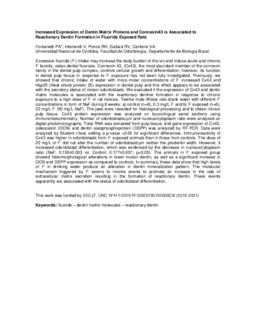| dc.contributor.author | Fontanetti, Pablo Alejandro | |
| dc.contributor.author | Interlandi, Victoria | |
| dc.contributor.author | Ponce, Rubén Hugo | |
| dc.contributor.author | Gallará, Raquel Vivian | |
| dc.contributor.author | Centeno, Viviana Andrea | |
| dc.date.accessioned | 2022-08-09T12:31:42Z | |
| dc.date.available | 2022-08-09T12:31:42Z | |
| dc.date.issued | 2020 | |
| dc.identifier.issn | 1523-4681 | |
| dc.identifier.uri | http://hdl.handle.net/11086/28076 | |
| dc.description.abstract | Excessive fluoride (F-) intake may increase the body burden of the ion and induce acute and chronic F- toxicity, osteo-dental fluorosis. Connexin 43, (Cx43), the most abundant member of the connexin family in the dental pulp complex, controls cellular growth and differentiation; however, its function in dental pulp tissue in response to F- exposure has not been fully investigated. Previously, we showed that chronic intake of water with micro-molar concentrations of F- increased Cx43 and Hsp25 (Heat shock protein 25) expression in dental pulp and this effect appears to be associated with the secretory status of incisor odontoblasts. We evaluated if the expression of Cx43 and dentin matrix molecules is associated with the reactionary dentine formation in response to chronic exposure to a high dose of F- in rat incisors. Twelve male Wistar rats drank water with different F- concentrations in form of NaF during 8 weeks: a) control (n=6), 0.3 mg/L F- and b) F- exposed (n=6), 22 mg/L F- (50 mg/L NaF). The jaws were resected for histological processing and to obtain incisor pulp tissue. Cx43 protein expression was analyzed on buccolingual serial sections using immunohistochemistry. Number of odontoblasts/µm and nucleus/cytoplasm ratio were analyzed on digital photomicrographs. Total RNA was extracted from pulp tissue, and gene expression of Cx43, osteocalcin (OCN) and dentin sialophosphoprotein (DSPP) was analyzed by RT-PCR. Data were analyzed by Student t test, setting a p-value <0.05 for significant differences. Immunoreactivity of Cx43 was higher in odontoblasts from F- exposed animals than in those from controls. The dose of 22 mg/L of F- did not alter the number of odontoblast/µm neither the predentin width. However, it increased odontoblast differentiation, which was evidenced by the decrease in nucleus/cytoplasm ratio (NaF: 0.150±0.003 vs. Control: 0.177±0.007; p<0.05). The animals in F- exposed group showed histomorphological alterations in lower incisor dentin, as well as a significant increase in OCN and DSPP expression as compared to controls. In summary, these data show that high levels of F- in drinking water produce an alteration in dentin mineralization pattern. The molecular mechanism triggered by F- seems to involve events to promote an increase in the rate of extracellular matrix secretion resulting in the formation of reactionary dentin. These events apparently are associated with the status of odontoblast differentiation. | es |
| dc.format.medium | Impreso | |
| dc.language.iso | eng | es |
| dc.rights | Attribution-NonCommercial-ShareAlike 4.0 International | * |
| dc.rights.uri | https://creativecommons.org/licenses/by-nc-sa/4.0/ | * |
| dc.subject | Fluoride | es |
| dc.subject | Dentin | es |
| dc.subject | Rats | es |
| dc.title | Increased Expression of Dentin Matrix Proteins and Connexin43 is Associated to Reactionary Dentin Formation in Fluoride Exposed Rats | es |
| dc.type | conferenceObject | es |
| dc.description.fil | Fil: Fontanetti, Pablo Alejandro. Universidad Nacional de Córdoba. Facultad de Odontología. Departamento de Biología Bucal; Argentina. | es |
| dc.description.fil | Fil: Interlandi, Victoria. Universidad Nacional de Córdoba. Facultad de Odontología. Cátedra Química Biológica A; Argentina. | es |
| dc.description.fil | Fil: Ponce, Rubén Hugo. Universidad Nacional de Córdoba. Facultad de Odontología. Cátedra Química Biológica A; Argentina. | es |
| dc.description.fil | Fil: Gallará, Raquel Vivian. Universidad Nacional de Córdoba. Facultad de Odontología. Cátedra Química Biológica A; Argentina. | es |
| dc.description.fil | Fil: Centeno, Viviana Andrea. Universidad Nacional de Córdoba. Facultad de Odontología. Cátedra Química Biológica A; Argentina. | es |
| dc.description.field | Bioquímica y Biología Molecular (ídem 1.6.3) | |
| dc.conference.city | New Jersey | |
| dc.conference.country | Estados Unidos | |
| dc.conference.editorial | Wiley | |
| dc.conference.event | ASBMR Annual Meeting 2020 | |
| dc.conference.eventcountry | Estados Unidos | |
| dc.conference.eventdate | 2020-9 | |
| dc.conference.institution | ASBMR | |
| dc.conference.journal | Journal od Bone and Mineral Research | |
| dc.conference.publication | Revista | |
| dc.conference.work | Resumen | |
| dc.conference.type | Congreso | |





